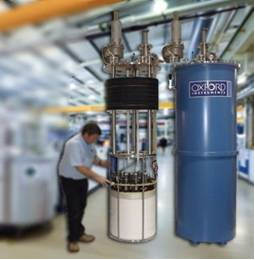Oxford Instruments has successfully developed and installed a compact, high field, high stored energy superconducting magnet system at the Dresden High Magnetic Field Laboratory (Hochfeld-Magnetlabor Dresden – HLD) within the Helmholtz-Zentrum Dresden-Rossendorf (HZDR) in Germany.
The success of commissioning is the end result of significant advances made in magnet engineering throughout the programme.

This new magnet generates 19 Tesla within a large magnet bore of 150 mm, operating at 4.2 K, the normal boiling point of liquid helium. Until recently, such combinations of high magnetic field and large bore size or sample space could only be achieved by super-cooling the magnet to 2.2 K by the use of further cooling applied to the liquid helium. The magnet for HLD has been specifically designed to accommodate high temperature superconductor (HTS) insert coils targeting even higher fields, in addition to a wide range of sample configurations for experiments such as the high field magnetisation of magnetic materials.
Prof. Dr. Joachim Wosnitza, Director of HLD commented:
"At HLD, we operate a pulsed magnetic field facility for international researchers. Besides that, we study the structure and function of modern materials together with our cooperation partners by use of high magnetic fields. There were significant electro-mechanical and thermal challenges in development and manufacture of high field, wide bore superconducting magnets required by HLD. We rely on experienced partners and suppliers to provide stable and reliable magnets, and we chose Oxford Instruments because of their depth and range of expertise in this field, as well as their long experience in installing such systems globally. HLD is very pleased with the commissioning of yet another high capacity magnet system from Oxford instruments. The installation of this system went very smoothly. The whole process from delivery to completion has been hassle free and one of the best we have ever experienced so far”.
There are two particular challenges to overcome in the design and manufacture of such a leading-edge superconducting magnets – the stresses within the magnetic coils, and the management of the very high stored energy within the magnet. To manage the extermely large coil stresses, Oxford Instruments combined extensive modelling with innovative construction techniques in order to produce the reliable high field niobuim tin superconductor coils required.
The energy stored in such a magnet when at its full field is enormous – in this case 5.7 MJ (MegaJoules). Should the magnet “quench” – in other words, rapidly lose its superconductivity – this energy is dissipated within just a few seconds. For comparison, this is approximately the same stored energy as a Volvo FH 550/610 truck tractor unit weighing 9.68 metric tonnes travelling at 124 kph (77 mph). For the HLD magnet, a new quench energy management system was developed and extensively tested before being proven on the full magnet system.
Dr Ziad Melhem, Alliances Manager at Oxford Instruments NanoScience said:
“We are delighted by this major achievement, which results from working closely with our colleagues and partners at the HLD at various stages of the product development and sets new records for superconducting research magnets using LTS materials. This new magnet system will help accelerate materials research and enable new innovations and discoveries in a high field environment”.
In its research programme, HLD already operates a number of Oxford Instruments’ superconducting magnet systems including a high field research magnet generating 20 T at 4.2 K and 22 T at 2.2 K – presently the state of the art for low temperature superconducting (LTS) niobium titanium (NbTi) and niobium tin (Nb3Sn) superconducting wires.
An essential enabling factor in these powerful high-field magnets has been the development of RRP® (rod restack process) niobium tin conductor by Oxford Superconducting Technology (OST – Carteret, NJ, USA), a member of the Oxford Instruments group of companies. The RRP conductor is a specialised high-performance product geared towards optimised performance for ultra-high field superconducting magnets. The close cooperation over an extended period between OST as conductor manufacturer and the Oxford Instruments magnet engineering team is a key factor in allowing units such as this to be built.
Dr Michael Cuthbert, Managing Director of Oxford Instruments NanoScience said:
“The completion of this magnet is confirmation of Oxford Instruments’ world-class capability to develop state of the art high field superconducting magnet systems. Our strong track record in the development and manufacture of unique superconducting magnet products is underpinned by our commitment to enable our customers to push the boundaries of their research. By utilising our RRP technology and high field, high energy coil designs we are able to offer National Facility grade performance of high magnetic field in compact lab scale environment”.
High magnetic fields are needed by the research community in physical and life sciences to explore new areas in nanoscience, nanotechnology, bioscience and materials research. Moreover, high fields in combination with low temperature are a crucial aid in studying, modifying and control new states of matter required. This enables new innovations by discovering advanced materials and allows studies at the nano scale. Superconducting magnets provide high magnetic fields without the enormous power consumption and large infrastructure requirements of resistive magnets.
Read more at www.oxford-instruments.com/